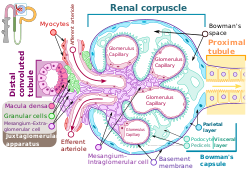Juxtaglomerular apparatus
This article needs additional citations for verification. (May 2015) |
| Juxtaglomerular apparatus | |
|---|---|
 A renal corpuscle, showing the juxtaglomerular apparatus with Juxtaglomerular cells (granular cells), Macula densa cells and, extraglomerular mesangium. | |
| Identifiers | |
| MeSH | D007606 |
| FMA | 83599 |
| Anatomical terminology | |
The juxtaglomerular apparatus (also known as the juxtaglomerular complex) is a structure in the kidney that regulates the function of each nephron, the functional units of the kidney. The juxtaglomerular apparatus is named because it is next to (juxta-[1]) the glomerulus.
The juxtaglomerular apparatus consists of three types of cells:
- the
- juxtaglomerular cells, (also known as granular cells) which secrete renin
- extraglomerular mesangial cells
Location
The juxtaglomerular apparatus is part of the kidney
Function
Juxtaglomerular cells

- Stimulation of the beta-1 adrenergic receptor
- Decrease in renal perfusion pressure (detected directly by the juxtaglomerular cells)
- Decrease in NaCl concentration at the macula densa, often due to a decrease in glomerular filtration rate
Extraglomerular mesangial cells
Macula densa
At the point where the afferent arterioles enter the glomerulus and the efferent arteriole leaves it, the tubule of the nephron touches the arterioles of the glomerulus from which it arose. At this location, in the wall of the last portion of distal straight tubule, there is a modified region of tubular epithelium called the macula densa.(Fig. 5 in Kumaran and Hanukoglu 2020)[5] Cells in the macula densa respond to changes in the sodium chloride levels in the distal tubule of the nephron via the tubuloglomerular feedback (TGF) loop. Within the thick ascending limb of the loop of Henle, the distal convoluted tubule begins immediately following the macula densa. [2][3]
The macula densa's detection of elevated sodium chloride, which leads to a decrease in GFR, is based on the concept of
When there is a decrease in the sodium concentration, less sodium is reabsorbed in the macular densa cells. The cells increase the production of
See Also: TGF mechanism.
Clinical significance
Excess secretion of renin by the
One cause of this can be increased renin production due to
See also
- Kidney
- Renal corpuscle
- Juxtaglomerular cell tumor
- Hyperaldosteronism
- Tubuloglomerular feedback
- Myogenic mechanism
References
- ^ "Dictionary.com". Retrieved 11 June 2015.
- ^ PMID 30354966.
- ^ a b c "Tubuloglomerular Feedback - an overview | ScienceDirect Topics".
- ^ ISBN 978-1-25-902753-6.
- PMID 31605441.
- PMID 20519378.
- PMID 24265071.
External links
